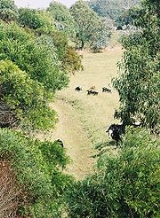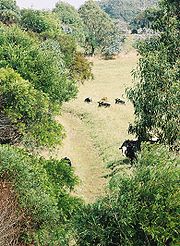
Keyline Design
Encyclopedia

Topography
Topography is the study of Earth's surface shape and features or those ofplanets, moons, and asteroids...
linked to water flow. Beyond that however, Keyline can be seen as a collection of design principles, techniques and systems for development of rural and urban landscapes.
Keyline design was developed in Australia by farmer and engineer P. A. Yeomans
P. A. Yeomans
Percival Alfred Yeomans was an Australian inventor known for the Keyline system for the development of land and increasing the fertility of that land. As a mining engineer and gold assayer, Yeomans had developed a keen sense of hydrology and equipment design...
, and described and explained in his books The Keyline Plan, The Challenge of Landscape, Water For Every Farm and The City Forest.
Application
P. A. YeomansP. A. Yeomans
Percival Alfred Yeomans was an Australian inventor known for the Keyline system for the development of land and increasing the fertility of that land. As a mining engineer and gold assayer, Yeomans had developed a keen sense of hydrology and equipment design...
published the first book on Keyline in 1954. Yeomans described a system of amplified contour ripping to control rainfall run off and enable fast flood irrigation of undulating land without the need for terracing.
Keyline Designs include irrigation dams equipped with through-the-wall Lockpipe systems to gravity feed irrigation, stock water and yard water. Graded earth channels may be interlinked to broaden the catchment areas of high dams, conserve the height of water and transfer rainfall run-off into the most efficient high dam sites. Roads follow both ridge lines and water channels to provide easier movement across the land.
Keyline Scale of Permanence
The Keyline Scale of Permanence identifies typical farms elements ordered according to their degree of permanence. Keyline considers these elements when planning the placement of water storage, roads, trees, buildings and fences. On undulating land, a keyline approach involves identifying several features namely ridges and valleys and the natural water courses seeking optimum water storage sites and potential interconnecting channels.The water lines identified from the land-form subsequent provide optimal locations for the various less permanent elements (roads, trees, buildings and fences) to optimise the natural potential of the landscape.
Keypoint
In a smooth grassy valley, a location called the Keypoint can be found where the lower and flatter portion of a primary valley floor suddenly steepens. The – Keyline – of this primary valley is revealed by pegging a contour line through the keypoint, within the valley shape. All the points on the line are at the same elevation as the keypoint. Contour plowing parallel to the Keyline, both above and below will automatically become "off-contour" but the developing pattern will tend to drift rainwater runoff away from the valley centre and incidentally, prevent erosion.Keyline pattern cultivation on ridge shapes is done parallel to any suitable contour but only working on the upper side of the contour guide line. This automatically develops a pattern of off-contour cultivaton in which all the rip marks left in the soil will slope down towards the centre of the ridge shape. This pattern of cultivation allows more time for water to soak in. Keyline pattern cultivation also enables controlled flood irrigation of undulating land, which further assists in the fast development of deep biologically fertile soil, which results in improving soil nutrition and health.
In many countries including Australia, it is important to get optimum absorption of rainfall and Keyline cultivation does this as well as delaying the potentially damaging concentration of runoff. The Yeomans technique differs from traditional contour plowing in several important respects. Random contour plowing
Contour plowing
Contour plowing or contour farming is the farming practice of plowing across a slope following its elevation contour lines. The rows formed slow water run-off during rainstorms to prevent soil erosion and allow the water time to settle into the soil...
also becomes off contour but usually with the opposite effect on runoff water causing it to quickly shed off ridge shapes and be concentrated in valleys. The limitations of the traditional system of soil conservation, with its "safe disposal" approach to farm water
Farm water
Farm water, also known as agricultural water, is water committed for use in the production of food and fibre. On average, 70 per cent of the fresh water withdrawn from rivers and groundwater is used to produce food and other agricultural products...
was an important motivational factor in the development of the Keyline system.
Applications
David HolmgrenDavid Holmgren
David Holmgren is an ecologist, ecological design engineer and writer. He is known as one of the co-originators of the permaculture concept with Bill Mollison.- Life and work :Holmgren was born in the state of Western Australia...
, one of the founders of Permaculture
Permaculture
Permaculture is an approach to designing human settlements and agricultural systems that is modeled on the relationships found in nature. It is based on the ecology of how things interrelate rather than on the strictly biological concerns that form the foundation of modern agriculture...
, used Yeoman's Keyline principle extensively in the formulation of Permaculture concepts and the design of sustainable human settlements and organic farms
Organic farming
Organic farming is the form of agriculture that relies on techniques such as crop rotation, green manure, compost and biological pest control to maintain soil productivity and control pests on a farm...
.
A topographical example can be seen on (37.159154°N 144.252248°W).
Keyline also includes concepts for rapid soil fertility enhancement and these concepts are explored in Priority One by P. A. Yeomans' son Allan. Yeomans and his sons were also instrumental in the design and production of special plows and cultivating equipment for use in conjunction with the keyline methodology.
See also
- Conservation biologyConservation biologyConservation biology is the scientific study of the nature and status of Earth's biodiversity with the aim of protecting species, their habitats, and ecosystems from excessive rates of extinction...
- Conservation ethicConservation ethicConservation is an ethic of resource use, allocation, and protection. Its primary focus is upon maintaining the health of the natural world: its, fisheries, habitats, and biological diversity. Secondary focus is on materials conservation and energy conservation, which are seen as important to...
- Conservation movementConservation movementThe conservation movement, also known as nature conservation, is a political, environmental and a social movement that seeks to protect natural resources including animal, fungus and plant species as well as their habitat for the future....
- EcologyEcologyEcology is the scientific study of the relations that living organisms have with respect to each other and their natural environment. Variables of interest to ecologists include the composition, distribution, amount , number, and changing states of organisms within and among ecosystems...
- EnvironmentalismEnvironmentalismEnvironmentalism is a broad philosophy, ideology and social movement regarding concerns for environmental conservation and improvement of the health of the environment, particularly as the measure for this health seeks to incorporate the concerns of non-human elements...
- Environmental protectionEnvironmental protectionEnvironmental protection is a practice of protecting the environment, on individual, organizational or governmental level, for the benefit of the natural environment and humans. Due to the pressures of population and our technology the biophysical environment is being degraded, sometimes permanently...
- Habitat conservationHabitat conservationHabitat conservation is a land management practice that seeks to conserve, protect and restore, habitat areas for wild plants and animals, especially conservation reliant species, and prevent their extinction, fragmentation or reduction in range...
- Natural environmentNatural environmentThe natural environment encompasses all living and non-living things occurring naturally on Earth or some region thereof. It is an environment that encompasses the interaction of all living species....
- Natural capitalNatural capitalNatural capital is the extension of the economic notion of capital to goods and services relating to the natural environment. Natural capital is thus the stock of natural ecosystems that yields a flow of valuable ecosystem goods or services into the future...
- Natural resourceNatural resourceNatural resources occur naturally within environments that exist relatively undisturbed by mankind, in a natural form. A natural resource is often characterized by amounts of biodiversity and geodiversity existent in various ecosystems....
- Renewable resourceRenewable resourceA renewable resource is a natural resource with the ability of being replaced through biological or other natural processes and replenished with the passage of time...
- Sustainable agricultureSustainable agricultureSustainable agriculture is the practice of farming using principles of ecology, the study of relationships between organisms and their environment...
- SustainabilitySustainabilitySustainability is the capacity to endure. For humans, sustainability is the long-term maintenance of well being, which has environmental, economic, and social dimensions, and encompasses the concept of union, an interdependent relationship and mutual responsible position with all living and non...
- Water conservationWater conservationWater conservation refers to reducing the usage of water and recycling of waste water for different purposes such as cleaning, manufacturing, and agricultural irrigation.- Water conservation :Water conservation can be defined as:...
- Soil salinationSoil salinationSoil salinity is the salt content in the soil.- Causes of soil salinity :Salt-affected soils are caused by excess accumulation of salts, typically most pronounced at the soil surface. Salts can be transported to the soil surface by capillary transport from a salt laden water table and then...
Notations
- Yeomans, P. A., The Keyline Plan (1954) Free online version
- Yeomans, P. A., The Challenge of Landscape : the development and practice of keyline, Keyline Pub. Pty., Sydney, (1958). Free online version
- Yeomans, P. A., Water for Every Farm: A practical irrigation plan for every Australian property, K.G. Murray Publishing Company, Pty, Ltd, Sydney, N.S.W., Australia (1973) ISBN 0-646-12954-6/ISBN 0-909325-29-4.
- Yeomans, P.A., The City Forest (1971) Keyline Publishing Pty Ltd., ISBN 0959957804. Free online version
- Yeomans, P.A. & K.B., Water for Every Farm - Yeomans Keyline Plan (1993, 2002,3,7) Keyline Designs. ISBN 9781-0-646-41875-9
- Yeomans, P.A. & K.B., Water for Every Farm - Yeomans Keyline Plan (2008) Keyline Designs. ISBN 978-14388225784.
Available from: Keyline Designs or Amazon
- Yeomans, A., Priority One: Together we Can Beat Global Warming, Keyline Publishing Co. (2005) ISBN 0-646-43805-0 online version
- MacDonald-Holmes, J., University of Sydney, Geographical and Topographical Basis of Keyline
- Spencer, L, Keyline and Fertile Futures (2006) Online Version

